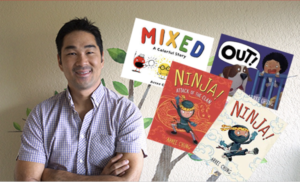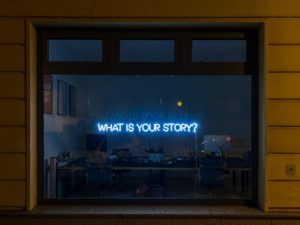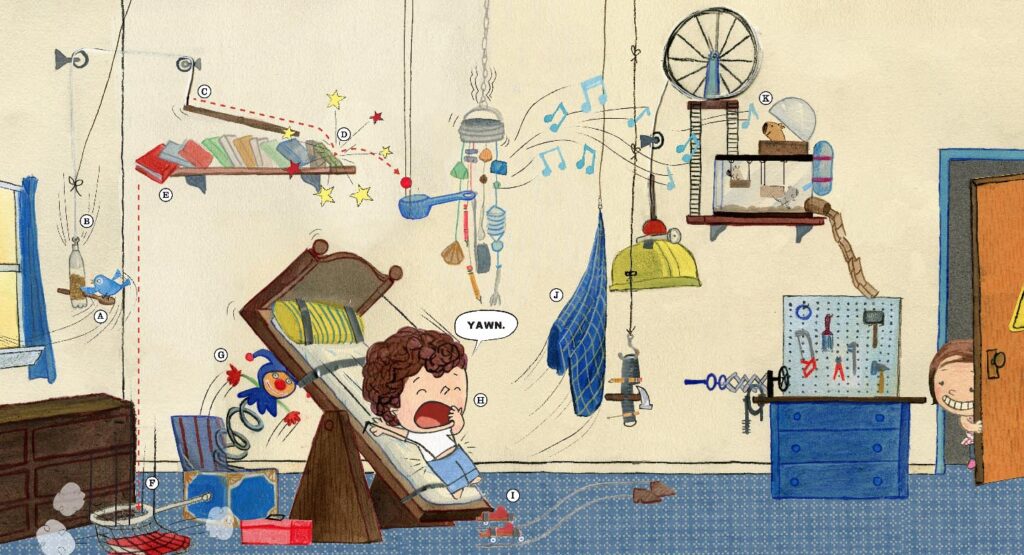

So you’re ready to learn how to publish your children’s book? There are two primary paths to publication, and below we’ll walk you through the differences, the pros and cons, and the steps you need to take for each.
The first way to get published is through traditional publication. This is the method you’re probably most familiar with. The vast majority of the books on your bookshelves and in your bookstore were traditionally published by a publishing house.
The second way is to self-publish. When you self-publish, you become your own publisher using a variety of service providers to bring your book to life.
Regardless of which path you end up on, the first step to publication is the same: write a great story.
I know you want to breeze past this section because, let’s be honest, who doesn’t think their story is great? But don’t. Starting here can save you loads of time and money.
We’ve put together a list of questions that you should ask yourself to uncover if you’re ready to start planning for publication:

Does your story . . .
Did your story . . .
Did you . . .
If you hesitated even a nano-second at any of those questions, head over to our article, How to Write a Children’s Book so that you can get your story in tip-top shape.

Is your story ready? (Feels good, right?) Now you get to choose your path: traditional publishing or self-publishing, but . . . how do you decide? Here are some questions to consider:
Is your story ready? (Feels good, right?) Now you get to choose your path: traditional publishing or self-publishing, but . . . how do you decide? Here are some questions to consider:
This is a long, hard, competitive road (sorry, we can’t lie!), but 99% of the time, you’re going to end up with a book that is high quality and well distributed. Fairly or not, there is certain gravitas associated with having your book traditionally published.
When you select this route, you concede profits and control for reduced risk and expert resources. You don’t have to pay any money, and your focus remains solely on writing (and illustrating if you have that skill) excellent stories and marketing those that become books.
You have the benefit of professional editing, art direction, illustration selection, printing, and distribution from a team of experts in the industry. They love your story as much as you do and will put every effort into making it the best it can be.
But . . . there are a lot of people trying to publish their book this way, and the market can only handle so much. It is difficult to get your work seen, let alone acquired. The publishers have very high standards (they must!), and the whole process moves like molasses. It regularly takes years for a book to go from the first draft to publication.
Self-publishing is faster and allows you full control over the whole process. You get to be the one that decides how your book will look, when it will be released and where it will be sold (to an extent). You get your vision for your book. Full stop.
This is an excellent option for those business-minded creatives who are excited by the prospect of running their own business. Because, essentially, you become the publisher.
That all sounds great! What’s the downside? You carry all of the risks. Not only do you have to front the money for the whole production, but you also have to make all the decisions. This will include finding experts where and when you need them.
While we talk about “picking your path,” this is not something that is set in stone. You can jump into the query trenches to pursue the traditional route and then down the road take on self-publishing.
Or you could try your hand at self-publishing, and then for your next book, try selling it to a publisher. The one thing to keep in mind is that once a book is self-published, it is exceedingly rare (almost NEVER) that a traditional publisher will take it on. That book is what it is.
From here, your next steps will change based on your choice . . . like a choose your own adventure book!
What did you choose?

No, TECHNICALLY, you do not need an agent to get traditionally published, but it can make your life easier. A growing majority of publishers do not accept unsolicited manuscripts, so sometimes the only way in is through an agent.
An agent’s job is to represent you (and by extension, your books) in all aspects of the business. They have industry connections with editors and publishing houses, and a good agent will be able to get your manuscript in front of the right people at the right time.
They will advocate in your interests for contracting, and should any disputes arise, they will be your muscle. This frees you up to focus on the creative relationship.
An extremely important note about agents . . . they don’t get paid until you do. They only make money if they sell books. If someone says you need to pay them to be your agent, they are what we refer to as a “schmagent,” and you should run the other way.
The downside? It is difficult to get an agent. They are the gatekeepers to the publishing world in many respects. On top of that, even if you are a well-read, practiced creator, you still need to fit their list, fit the market, and approach them at just the right time.
So how do you do it?
We could do a whole class . . . wait, we DID do a whole class on this very subject . . . but here are your basic steps:

1. Write excellent manuscripts.
(That keeps coming up, doesn’t it?) If you’re a picture book writer you will want at least three fully polished manuscripts before you start querying. Why? Because nine times out of ten an agent wants to represent you for your body of work. They want you for your career. They can’t fall in love with just one story, they need to love you. If you’re an author/illustrator, you need one completed dummy and three fully illustrated spreads.
2. Research agents.
Your agent is like your professional soulmate. You need someone who will love you, love your work, and be as passionate about bringing it to life as you are. It is a waste of everyone’s time for you to query someone who is obviously the wrong fit. Look for agents that rep your genre, look at their manuscript wish lists and blog posts written about/by them. Start a spreadsheet or join QueryTracker to keep track of your research and your queries.
3. Query agents.
Writing a query letter is like an art unto itself. You’ll need to be able to hook the agent’s attention, quickly summarize your book, and share your bio in a succinct business letter.
Whew, after all that work to get an agent, you get to take a little breather!
Just kidding.
But, you do get to leave the business side to someone else. At this point you will work directly with your agent to decide what needs to be done to get ready to go out on submission. This oftentimes includes:
Then your agent will send your manuscript out to editors. Each agent handles this part of the process differently. Some use a spreadsheet to track, some communicate via email, etc. But the important thing is that they are sending your work out to those publishers that might be a good fit, and are keeping you updated on how it’s going.
Then, you wait.
While you’re waiting for your first submission to find its publishing home, you get back to the old grindstone. Write more stories!
At this point you’re working to establish your career as an author or author/illustrator. You will go through the whole process of creating more, and more, and more books. Work with your agent to select those to send to publishers and continue to rake in the acquisition contracts.

You thought that by going the traditional route you weren’t going to have to market didn’t you? Sorry to be the bearer of bad news, but much of the marketing falls to you, the creator. Depending on who you are, how long you’ve been writing, how many books you have, how well they’ve done, and who your publishers are, you may get some resources from the publisher. But it’s up to you to build your author business.
Some questions to consider:


You’re a publisher now, so you have a bunch of decisions to make. Your book(s) and your goals are going to be unique to you, so there aren’t “right” or “wrong” answers.
DISCLAIMER: We have a full nine-week course dedicated to walking through this process. This is not something that you can quickly learn in one article! But we do want to give you an idea of what to expect.
Here are some things you need to think about:
Who is your audience?
When you’re a publisher, the answer to this question goes deeper than “kids.” You need to decide whether you’re going to pursue the trade market (high concept, broad appeal) or the educational market (specific and niche). Who you’re selling to will influence your next decisions.
How will you print?
There are two types of printing available, off-set printing (good, ol’ fashioned, big printer printing) or print on demand (POD). POD is just like it sounds. As your books are ordered, they are printed and shipped. There are pros and cons to both options. Based on your audience, your budget, and your goals, you can choose the one that’s right for you.
How will you distribute?
Distribution is how you get your books into your readers’ hands. If you’ve decided to print on demand, both major players in that space (Amazon KDP and Ingramspark) have established distribution channels for you to use. If you offset print, you will need a distributor to warehouse and fulfill your orders.
Now that you have your plan in place, you need to set up the structure to put it into action. And to do that you need to build your team. Your own education, expertise, and experience will guide who you need to hire. A good rule of thumb is: when you don’t know what to do, hire an expert! You may need to hire:
You’ll also need to set your business up as a legal business entity. These decisions will have liability and tax implications and, remember when we said “if you don’t know what to do, hire an expert” earlier? This would be a great time to consult an attorney or accountant to help walk you through this process.
One last important thing to note: Contracts are everything! We recommend that you don’t use an online sourcing site’s contract. You should pay to get a boilerplate contract from an attorney, customize it on your terms, according to your business structure, and use your contract for all of your business relationships.


Finally, the moment you’ve been waiting for! You have your story finished, your business set up, and now you need to put the wheels into motion. You’re ready for formatting.
Regardless of what type of book you’re publishing, you will need to get your copyright page formatted correctly. You can use this checklist <<link to Darcy’s rec>> to find out what you need to put on this page and what librarians LIKE to see on this page.
You will need to decide whether you will be doing print books, ebooks, audiobooks, or some combination of the three. If you’re going to print, will you offer hardcover, paperback, or both? Each of these different paths will need to be formatted, and you may need to hire a professional to do it.
If you’ve decided to format yourself, we recommend the following software:
Now you’ve got this beautifully professional book, the perfect audience, an efficient distribution method and . . . you just need to tell everyone about it!
Easier said than done. This is not an “if you build it, they will come” sort of situation. You are a small business, and it’s your job to create demand for your product.
The first thing you need to ask yourself is: how will people find my book? You guessed it. Marketing. There are two types of marketing you can use: passive marketing and active marketing.
You do NOT need to do all of these things. These are different avenues available to you. Evaluate what your strengths are and what works best with the type of books you write. Pick a few strategies; learn how to do them well; and test the market. Then re-evaluate, and make changes as needed. Always track the ROI (return on investment), and make smart business decisions.
The best thing you can do is write the next book. There is an unwritten rule of thumb in self-publishing: 20 books = $50K. You have to keep writing and publishing books if you want this to be a sustainable business.
THE END
About 10 minutes ago, it seemed like such a great idea to publish your book. Now it might seem like . . . a not-so-great idea.
We’re not in the business of lying to people, so yes, it takes a lot of work.
BUT . . .
Take a second to think of the stories of your heart. Think of the kids who would read them. Imagine what a life would look like if you were spending your days building imaginary worlds, sharing strange and wonderful facts, or creating a sustainable creative business.


You were reading this article because of some creative itch you can’t scratch. Don’t listen to that little voice that’s telling you that you can’t do it. That voice thinks it’s too hard, will take too much time, or that you’re not capable.
But you know better. We know better.
You can do it. You are capable. Just take it one step at a time.
Write a great story.


As Chief Operating Officer of Storyteller Academy and a writer myself, I am fortunate to spend both my days and nights immersed in the world of children’s literature. I am an active member of SCBWI and you can spot me in all the fun kidlit communities. I was honored to have Kelly DiPucchio select me as her 2020 PBChat mentee.




Guest Post: Charlotte Watson Sherman
Instructor Stories: Darcy Pattison
Instructor Stories: Baptiste Paul
Instructor Stories: Isabella Kung
Challenges & Twitter Events for Kidlit Creators
Use Mentor Texts to Write Chapter Books